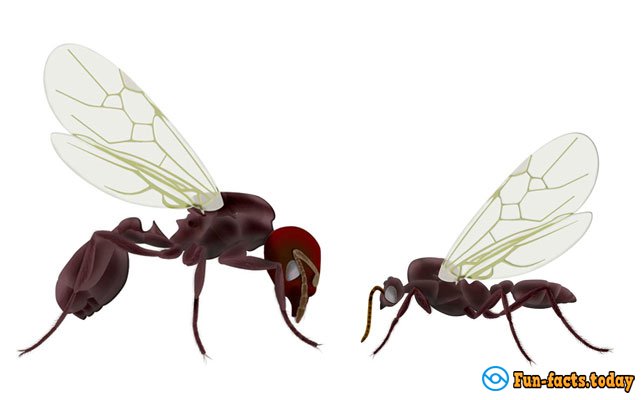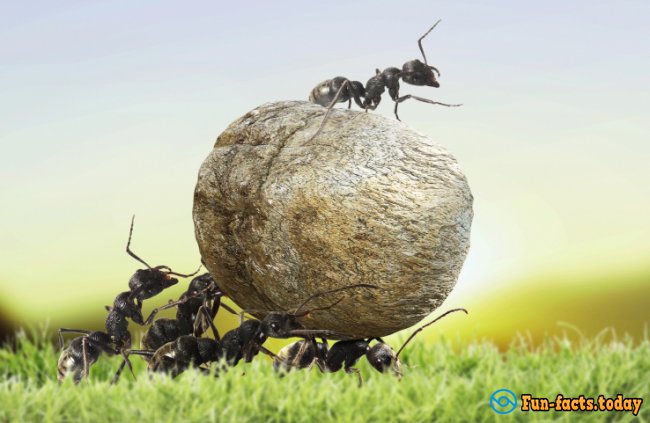1. Ants lead war in patterns like human beings do. They even make use of more propelled techniques like studying and pushing weaker ants to the war front line to shield the brave ones.
2. Ants make use of “social vaccination,” i.e. on the possibility that one is contaminated with a disease, despite they lick the affected insect, dispersing it all through the colony. This practice kills a portion of the spores and constructs safe resistance.

3. Leaf cutter ants don’t eat leaves. They nurture the leaves to a flea inside their habitat and subsequently sustain off the flea.
4. Turtle Ant is a species of ant whose head has advanced into a “door” that can obstruct any entry to its home.
5. An analysis discovered that 20% of worker ants in colonies put in nothing to the development of the colony and are viewed as “Lazy Ants”
6. After an ant colony is complete and has adequate assets to spare, winged ants start to increase.
7. Ants can’t be truly harmed from contact with the ground subsequent to being dropped from any height, because they don’t contain adequate mass.
8. Queen ants have the longest existence than any known bug, up to 28 years
9. Such is the quality of the ant’s jaws that in East Africa, they are utilized as common, crisis sutures. Different East African local tribal people, when wounded will utilize the soldiers to join the injury by getting the ants to bite on both sides of the cut, then severing the body. This utilization of ants as temporary surgical staples makes a seal that can hold for a considerable length of time at once.
10. Just two species on earth have learnt to rule different species, humans and ants. There are 14 types of ants that can likewise oppress other ants.
11. Dead ants emanate a substance that notifies the other ants to move the body to a graveyard. On the off chance that this substance is splashed on live insect, other ants will regard it as a dead insect, paying little notice to what the live ant does.
12. An ant mill is an experiment performed by ants in which ants that are visually impaired, are isolated from the primary scrounging party, lose the pheromone track and start to tail each other, making a ceaseless turning circle. The ants in turn usually later die of fatigue.
13. The nineteenth century scholar Sir John Lubbock probed ants by getting them tanked. He found that calm ants would convey their tipsy insect companions back to their home, in the event that they were from a similar province, yet they toss drunk strangers into water.
14. A type of parasitic butterfly named Phengaris rebeli whose larvae emulate ant larvae so the worker ants will fend for them. They then climb to the most elevated social statuses by impersonating the sound of the queen of the ant colony.
15. ‘Ant colony garnets’ are little expensive pebbles that are “mined” by ants in some parts of Arizona. Ants discover the garnets while burrowing their ant colony dwelling places, drag them out, and dispose of them on the outside
16. The adolescent queens of a parasitic ant type called Solenopsis daguerrei will penetrate homes of different species, for example a fire ant settlement, execute their queen and have her spot. The workers bring up the impostor’s kids, which then take off to fill more settlements. They are being considered as an organic technique to control the spread of fire ants.
17. Male ants don’t have fathers; on the grounds that unfertilized eggs get to be males while prepared eggs get to be females.
18. A few types of carpenter ants can detonate voluntarily. If all else fails they get their abs to crack their inner organs, bringing about a self-destructive burst of immobilizing paste.
19. There is a kind of profound insect named Pheidole harrisonfordi to pay acknowledgment to the on-screen character’s (Harrison Ford) purpose as a modest and ecologist
20. At the point when skydiver Joan Murray’s fundamental parachute and reinforcement parachute fizzled, she moved toward the ground at 130 kilometers for each hour, arrival on a hill of fire ants. Specialists trust that the stun of being stung more than 200 times by the ants discharged a surge of adrenaline, which kept her heart pumping.












